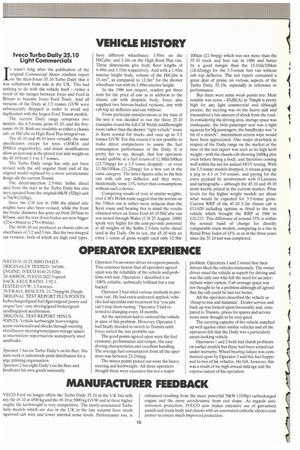VEHICLE HISTORY
Page 157

If you've noticed an error in this article please click here to report it so we can fix it.
have different wheelbases: 3.95m on the HiCube; and 3.2m on the High Roof Plus van. These dimensions give body floor lengths of 4.49m and 3.53m respectively. And with a 1.93m interior height body, volume of the HiCube is 15.4m3, as compared to 12.0m3 for the shorter wheelbase van with its 1.89m interior height.
In the 1986 test resport, readers got three tests for the price of one as in addition to the chassis cab with dropside body, Iveco also supplied two boxvan-bodied versions, one with cab top air deflector and one without.
From particular considerations at the time of the test it was decided to run the three 35.10 examples round the full CM Welsh middleweight route rather than the shorter "light vehicle" route in Kent normal for trucks and vans up to 3.5 tonnes GVW. For this reason it is not possible to make direct comparisons to assess the fuel consumption performance of the Daily. It is pretty fair to say, though, that few operators would quibble at a fuel return of 11.881ff/100km (23.73mpg) for a 3.5 tonne dropside or even 13.31it/100km (21.23mpg) for a box van in the same category. The latter figures refer to the box van with cab top deflector and they were, incidentally, some 13% better than consumptions without such a device.
Comparing results of tests at similar weights, over CM's Welsh route suggest that the terrain on the 338km run is rather more arduous than the Kent route and bearing this in mind the results obtained when an Iveco Ford 45.10 HiCube van was tested through Wales (CM 25 August, 1988) speak very highly for the cost-per-mile potential at all weights of the Sofim 2.5-litre turbo diesel used in the Daily. On its test. the 45.10 with an extra 1 tonne of gross weight used only 12.9111/
100km (21.9mpg) which was not more than the 35.10 truck and box van in 1986 and better by a good margin than the 15.011it/I0Okm (18.82mpg) for the 3.5-tonne box van without cab top deflector. The test report contained a great deal of praise on various aspects of the Turbo Daily 35.10s, especially in reference to performance.
But there were some weak points too: Most notable was noise 85dB(A) at 70mph is pretty high for any light commercial and although precise, the steering was on the heavy side and transmitted a fair amount of shock from the road. In considering the driving area, storage space was inadequate, the twin passenger seat was a tight squeeze for toig passengers, the handbrake was "a bit of a stretch", intermittent screen wipe would have been appreciated. One major drawback in respect of the Daily range on the market at the time of the test report was seen as its high kerb weight with the chassis cab showing 1600kg plus even before fitting a body, and therefore coming well within the net for annual HGV testing. With the 3.5-tonne models dropped, it means going up a peg to 4.5 or 5.0 tonnes. and paying for the extra payload by involvement with 0-Licences and tachographs although the 45.10 and 49.10 seem keenly priced in the current market. Price levels for the higher weight models are about what would be expected for 3.5-tonne gross. Current RRP of the 45.10 3.2m chassis cab is £13,620 including options as fitted to the test vehicle which brought the RRP in 1986 to £10,215. This difference of around 33% is within the normal band of change for directly comparable truck models, comparing to a rise in Retail Price Index of 15% or so in the three years since the 35.10 test was completed.














































































































































































